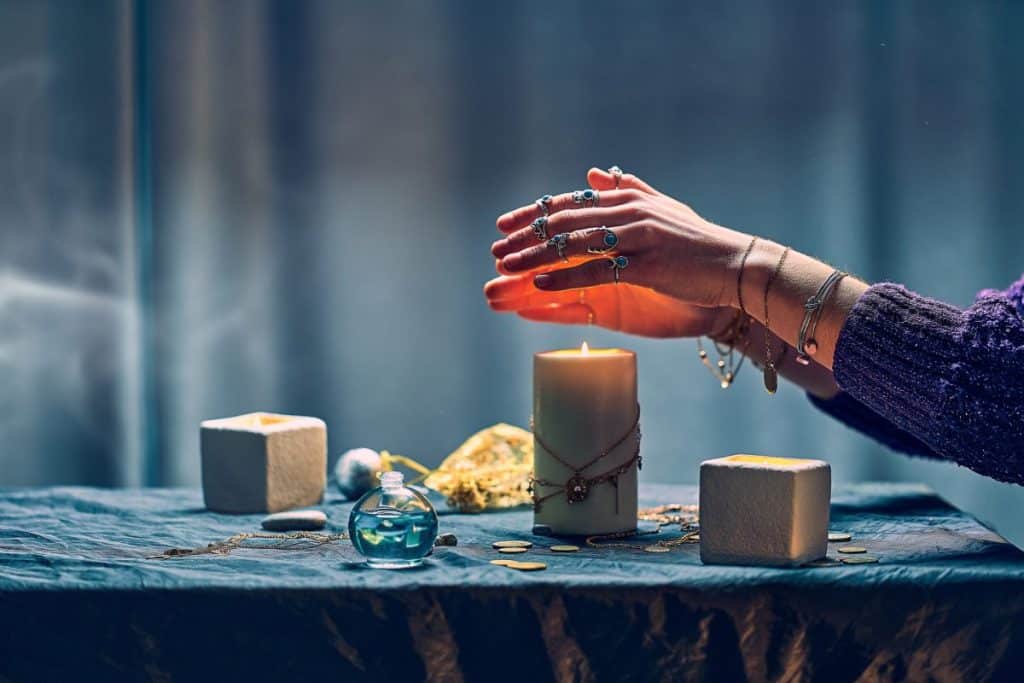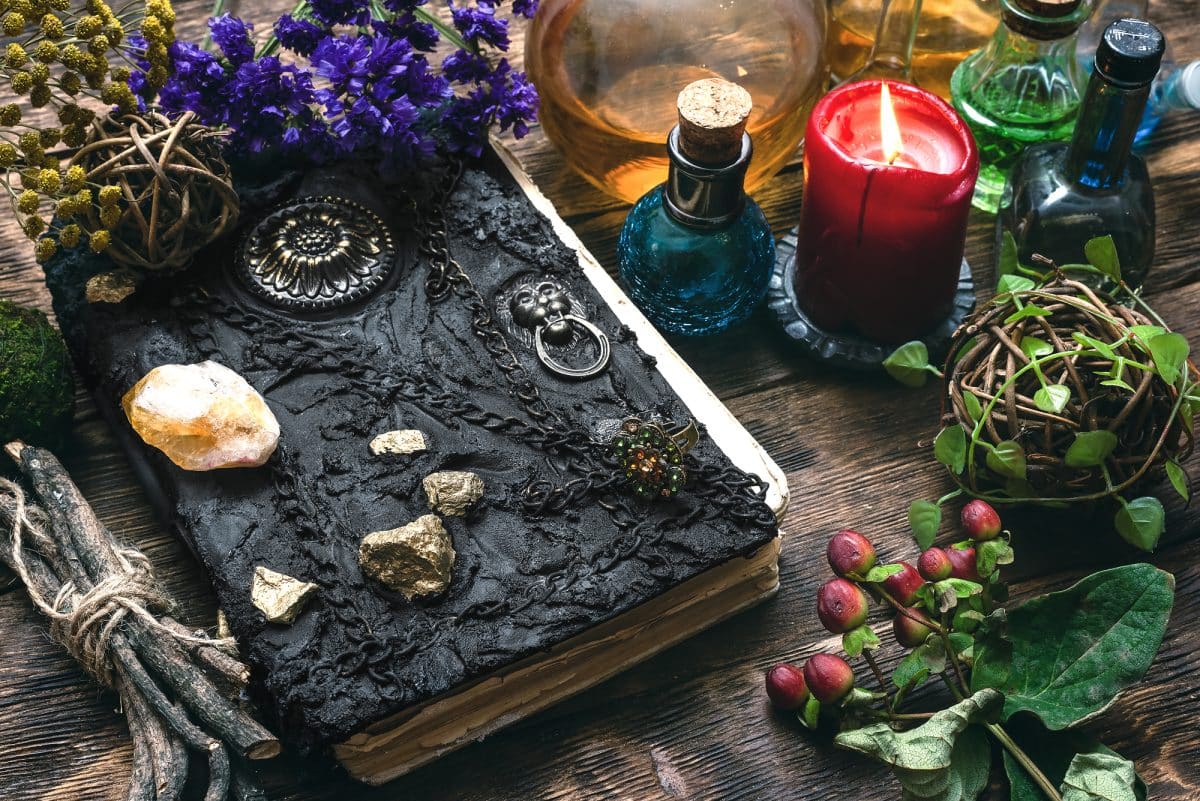The Different Types of Witchcraft: Origins, Beliefs, Practices, and Benefits
Witchcraft is a practice that has been around for centuries and continues to be an essential part of many people’s lives.
It is the use of occult means to influence the natural or supernatural world, and it has many different types, traditions, beliefs, skills, and practices.

Table of Contents
Types of Witchcraft
There are many different types of witchcraft, and each type has its unique history, philosophy, and practices. Here are some of the most popular types of witchcraft:
1. Wicca
Wicca is a modern pagan religion that originated in England during the mid-20th century. It is a nature-based religion that honors the Goddess and the God and celebrates the cycles of the seasons and the moon. Wiccans practice magic, divination, meditation, and ritual, and they often work in covens or as solitary practitioners.
Types of Wicca
- Gardnerian Wicca: founded by Gerald Gardner in the 1950s, it is the first modern tradition of Wicca.
- Alexandrian Wicca: founded by Alex Sanders in the 1960s, it combines elements of ceremonial magic, Hermeticism, Qabalah, and Egyptian mythology.
- Dianic Wicca: founded by Zsuzsanna Budapest in the 1970s, it focuses on female empowerment and goddess worship.
2. Traditional Witchcraft
Traditional Witchcraft is a term that encompasses various witchcraft traditions that predate Wicca and other modern forms of witchcraft. These traditions often have roots in European folklore, shamanism, herbalism, and divination. Traditional witches practice magic, divination, healing, and ritual, and they often work with spirits, ancestors, and deities.
Types of Traditional Witchcraft
- Stregheria: an Italian witchcraft tradition that honors the goddess Diana and the god Lucifer, and it involves working with spells, divination, and ritual.
- Hereditary Witchcraft: a witchcraft tradition that is passed down through families, and it often involves working with folk magic, herbalism, and divination.
- Hedge Witchery: a witchcraft tradition that focuses on healing, divination, and working with nature spirits and the fairy realm.
3. Eclectic Witchcraft
Eclectic Witchcraft is a type of witchcraft that combines elements from various traditions and practices according to one’s preference and intuition. Eclectic witches often create their spells, rituals, and practices, and they work alone or in groups.
4. Kitchen Witchery
Kitchen Witchery is a type of witchcraft that involves working with herbs, spices, and other ingredients to create magic spells, potions, and charms. Kitchen witches often use food and cooking as a form of ritual and magic.
5. Green Witchcraft
Green Witchcraft is a type of witchcraft that focuses on nature and the natural world. Green witches often work with herbs, plants, and trees, and they use them for healing, divination, and magic. They also have a deep connection with animals, spirits, and the environment.
6. Shamanic Witchcraft
Shamanic Witchcraft is a type of witchcraft that involves working with spirits, ancestors, and the elements. It combines shamanic practices, such as journeying, trance, and spirit work, with witchcraft practices, such as magic, divination, and ritual.
7. Sea Witchery
Sea Witchery is a type of witchcraft that focuses on the ocean, its creatures, and its magic. Sea witches often work with shells, seaweed, and other oceanic elements in their spells and rituals. They also have a deep connection with the moon and the tides, and they use them for divination and magic.
8. Reconstructionist Witchcraft
Reconstructionist Witchcraft is a type of witchcraft that seeks to reconstruct and revive ancient pagan traditions and practices. It often involves extensive research into historical texts, artifacts, and folklore. Reconstructionist witches often work with deities, spirits, and elements from a specific culture or region, such as Celtic, Norse, or Greek.
9. Ceremonial Witchcraft
Ceremonial Witchcraft is a type of witchcraft that uses ceremonial magic in its practices. It involves complex rituals, symbols, tools, languages, and invocations to communicate with spirits and deities. Ceremonial witches often work with the Kabbalah, the Tarot, and other occult systems.
10. Chaos Witchcraft
Chaos Witchcraft is a type of witchcraft that is based on the theory that belief is an active magical force. It uses various techniques to manipulate reality according to one’s will and desire. Chaos witches often experiment with different forms of magic and incorporate elements from various traditions.
11. Alexandrian Witchcraft
Alexandrian Witchcraft is a type of Wicca that was founded in England during the 1960s by Alexander Sanders, who claimed to be the “King of the Witches”. It combines elements of ceremonial magic, Hermeticism, Qabalah, and Egyptian mythology. Alexandrian witches often work in covens and perform complex rituals.
12. Dianic Witchcraft
Dianic Witchcraft is a type of Wicca that emphasizes female empowerment and goddess worship. It is mainly practiced by women and celebrates female cycles and rites of passage. Dianic witches often work with lunar energy and focus on healing and personal growth.
13. Draconic Wicca
Draconic Wicca is a type of Wicca that works with dragon energy and symbolism. It involves invoking dragons as guardians, guides, teachers, or allies in magic. Draconic witches often work with the elements and use meditation and visualization to connect with the dragon realm.
14. Faery Witchcraft
Faery Witchcraft is a type of witchcraft that connects with the faery realm and its inhabitants. It involves honoring the fae folk as allies or partners in magic. Faery witches often work with nature spirits, use divination tools, and practice shamanic journeying.
Benefits of Witchcraft
Witchcraft has many benefits, both for the practitioner and the community. Here are some of the most common benefits of witchcraft:
1. Spiritual Growth
Witchcraft can help you connect with your inner self, your spirituality, and your higher power. It can help you develop your intuition, your empathy, and your creativity. It can also help you discover your purpose, your values, and your goals in life.
2. Healing
Witchcraft can help you heal physically, emotionally, and spiritually. It can help you release negative emotions, beliefs, and patterns that are holding you back. It can also help you find peace, joy, and balance in your life.
3. Empowerment
Witchcraft can help you empower yourself and others. It can help you develop your confidence, your assertiveness, and your leadership skills. It can also help you inspire and support others in their journey of self-discovery and growth.
4. Connection
Witchcraft can help you connect with nature, the elements, and the universe. It can help you feel a sense of belonging and oneness with all living beings. It can also help you connect with like-minded people and build a supportive community.
5. Magic
Witchcraft can help you manifest your desires and dreams through magic. It can help you tap into your creative power and use it to create positive changes in your life and the world. It can also help you develop your psychic abilities, such as clairvoyance, clairaudience, and intuition.
How to Start Practicing Witchcraft
If you are interested in practicing witchcraft, here are some steps you can take to get started:
1. Learn
Read books, blogs, and websites about witchcraft. Attend workshops, classes, and conferences about witchcraft. Join online communities and forums about witchcraft. Ask questions and seek guidance from experienced practitioners.
2. Reflect
Reflect on your values, beliefs, and goals. Think about what you want to achieve through witchcraft. Consider your strengths, weaknesses, and challenges. Be honest and open-minded with yourself.
3. Explore
Explore different types of witchcraft and traditions. Try different practices, such as meditation, divination, and ritual. Experiment with different tools, such as crystals, candles, and herbs. Find what resonates with you and what works for you.
4. Practice
Practice witchcraft regularly and consistently. Create a sacred space for your practice, such as an altar or a room. Set intentions for your practice, such as healing, empowerment, or manifestation. Use your intuition and creativity to personalize your practice.
5. Connect
Connect with other practitioners and the community. Attend events, circles, and festivals. Join groups and organizations that align with your values and interests. Share your experiences and learn from others.
Conclusion
Witchcraft is a fascinating and empowering practice with many different types, traditions, beliefs, skills, and practices. Whether you are a curious beginner or an experienced practitioner, there is always something new to learn and discover.
Witchcraft can help you grow spiritually, heal, empower yourself and others, connect with nature and the universe, and create magic. It is a journey of self-discovery, transformation, and joy. So, embrace your inner witch and enjoy the ride!






